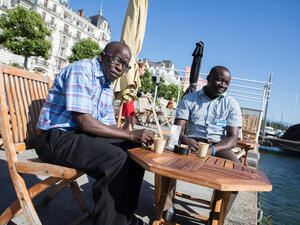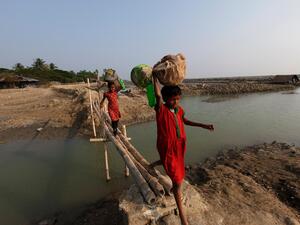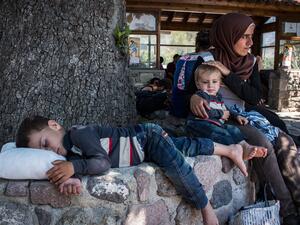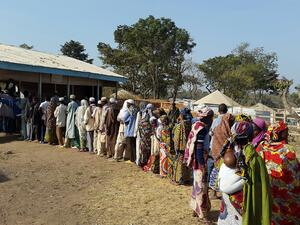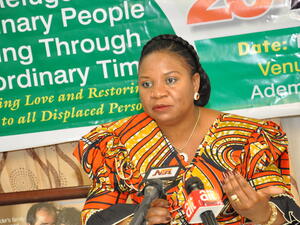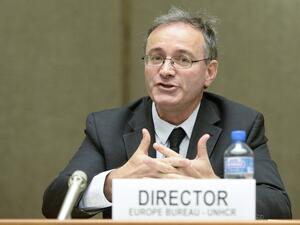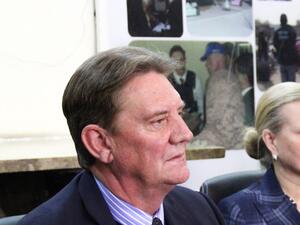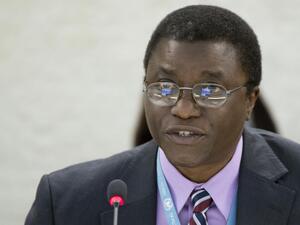Q&A: Brazilian bows out citing Mexico accord results as a highlight
Q&A: Brazilian bows out citing Mexico accord results as a highlight

Philippe Lavanchy at his farewell party in Geneva.
GENEVA, February 8 (UNHCR) - Brazilian Philippe Lavanchy planned to join his country's diplomatic service as a young man. He changed his mind when he was a university student and got a taste for humanitarian work during a holiday stint working for the International Committee for the Red Cross (ICRC) in Bangladesh. He joined the UN refugee agency in 1976, serving in Angola, and wrapped up his career last week as director of UNHCR's Americas Bureau. Lavanchy has worked in Europe, Asia, the Middle East and South America. On his last day at UNHCR, he discussed his work and shared his thoughts with Web Editor Leo Dobbs and Pretoria-based Senior Regional Global Public Information Officer Jack Redden. Excerpts from the interview:
Tell us a bit about the Americas Bureau and its work
Over the past three years, we have had a great team, both at headquarters and in the field. This was a key element in the successful implementation of the strategy we had for the region - the Mexico Plan of Action, or MPA [signed by 20 Latin American countries in 2004].
The MPA was a great achievement because it enabled us to get more visibility for the problems we faced in the region, particularly in Colombia and the surrounding countries. And this was despite the fact that we had closed many offices as democracy returned to countries like Argentina, Brazil, Chile and Uruguay. Through the MPA, we rebuilt a protection network in the region. Today, even those countries that are not directly affected by the conflict in Colombia are part of the exercise.
The MPA helped us not only in Colombia with IDPs [internally displaced people], which is a big problem, but also in Ecuador and Venezuela where you have big numbers [of Colombian refugees] as well as in countries which were not directly affected, like Brazil, Uruguay, Chile, Argentina and Paraguay. We even signed agreements to resettle refugees to these countries.
Another development has been the promulgation of legislation in several countries. The High Commissioner [for Refugees António Guterres] has praised Latin America as being the continent with the best legislation in the world on IDPs; the best continent as far as refugee legislation is concerned, the most generous. It's not just Brazil, Argentina, Ecuador - most of the countries now have fantastic legislation and a very positive attitude toward refugees.
As director of this bureau, I have had to continually fight to win more visibility for Colombia and convince the High Commissioner, the Deputy High Commissioner, the Assistant High Commissioners and other directors that they have to pay attention to this region. The attention of top management is focused on the big stories that run daily on TV, such as Iraq and Sudan. When you have a situation like Colombia that's been going on for more than 50 years, it's difficult to get attention and support - but the problem is there. We are talking about 3 million internally displaced and half-a-million refugees in the region.
Tell us more about the Mexico Plan of Action
The Mexico Plan of Action is an initiative from UNHCR. Twenty countries of Latin America, plus key donors like the United States, Scandinavia and Canada, participated in this meeting and adopted the MPA. It is a protection-oriented plan divided into two parts. The first one invites governments to develop instruments and legislation to implement the 1951 Geneva Convention and to protect refugees [and IDPs].... In most of the countries, I'm happy to say, we got extremely good results.
The second part deals with durable solutions. It is broken down into three sections: borders of solidarity, cities of solidarity and resettlement in solidarity. The first aspect helped us to develop, for example, UNHCR activities and assistance for refugees along Ecuador's border with Colombia.... We have 250,000 people in need of protection in Ecuador and they are being extremely well received - nobody is being refouled [forced back]. Under the second aspect, many cities in the region have decided to offer refugees the same access to things like health or education that they give their own nationals in need.
The third aspect has been key in helping us rebuild the protection network I mentioned earlier. It aims at making countries in the region face up to their responsibilities and help people rather than have them trying to make risky journeys to North America or Europe. Brazil, Chile, Argentina and now Paraguay and Uruguay have signed agreements with us offering to resettle refugees at risk, particularly from Ecuador and Costa Rica, or vulnerable groups who are facing continuing difficulties in host countries. The numbers of people being resettled in these countries is increasing, but we must not put pressure on them [to raise the numbers too quickly]. Proof that our approach was the right one came last year at the end of our international meeting here [last April] on Iraq, when Brazil offered to receive 200 Palestinians who were stuck on Iraq's border with Jordan. A few weeks later Chile did the same.
So is this a new development for the region?
The countries of Latin American are very different from one another.... But they do have an asylum tradition. The 1889 Montevideo Treaty on International Penal Law contained provisions on asylum and refugee protection and was one of the first of its kind in the world. The tradition in Latin America of territorial or political asylum is still very much respected by all countries. That facilitates our work a little bit.
We also have strong contacts with a lot of people in the region who have been refugees themselves. I sat recently in Chile with the minister for the presidency, Antonio Viera-Gallo, and I started talking about our work. He said: "You don't need to tell me anything about UNHCR.... UNHCR helped me leave Chile and I became a refugee in Rome. I was assisted by UNHCR and I was repatriated to my country by UNHCR." And many other ministers in Chile have been in the same situation. It's the same thing in Argentina. I was extremely well received by officials in Argentina because many of them are former refugees. Ditto with Brazil. The former president, Fernando Henrique Cardosa, was a refugee in France and the United States. When you sit with people like this, they know what you are talking about.
What about refugees who travel along mixed migration routes?
It's an extremely important issue, but it's not particularly new. In Latin America we have seasonal migrations that have been there for ages, centuries, of people leaving from the south and going to the north and coming back. Even between Latin American countries you had this migratory movement. It is true that this movement tends to increase the number of people wanting to go to the United States.
We have been pioneers in opening an office in Tapachula on the border between Mexico and South America to monitor people crossing the border and try - with the government and other UN agencies - to identify those who could be of concern to us. The results have been mixed. We even see the migration asylum nexus as part of the Mexico Plan of Action and we will probably become more vocal about this issue in the future.
What should UNHCR's priorities be going forward?
I think the decision of the High Commissioner to increase our role in helping IDPs was the right one. There wasn't really any agency dealing with the protection of IDPs in most situations, but UNHCR has a certain expertise that we can offer for these people. I think we have shown this in Colombia. For example, the legislation we have today in Colombia for IDPs is very sophisticated and very good. It is the result of a huge effort we made, not only with the government, but also with the Constitutional Court, the Ombudsman, MPs and so on. What is important now is to ensure that legislation passed in Bogota is implemented in the deep field.
The question of IDPs is crucial, but we must also continue to take our work with refugees seriously and we should not let either concern be diluted by other issues.
What other issues were you thinking of?
The question of migration. I think we have to be there for the protection of refugees, but we have to be very clear in our message to avoid things boomeranging on UNHCR.
Tell us about joining UNHCR
When I joined in 1976, UNHCR was a relatively small agency - it had only 800 people worldwide - and hiring procedures were much simpler. Sadruddin Aga Khan was High Commissioner at the time. I was contacted when I was working for ICRC in Israel and the occupied territories and asked if I was interested in joining UNHCR. They offered me a post in Mexico and I immediately accepted.
When I arrived at the UNHCR headquarters in Geneva, which were then on one floor in the Palais [des Nations], I was in a good mood. I arrived at the personnel department and someone said, "Ah, you are Lavanchy?" I said yes, I was the guy going to Mexico. "No, no, you're going to Angola." But it was a very interesting and challenging assignment with no R&R [Rest & Recuperation] ... and I soon caught the "UNHCR virus."


